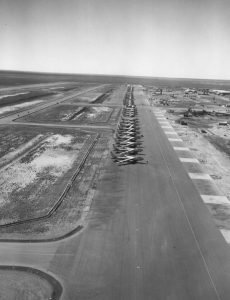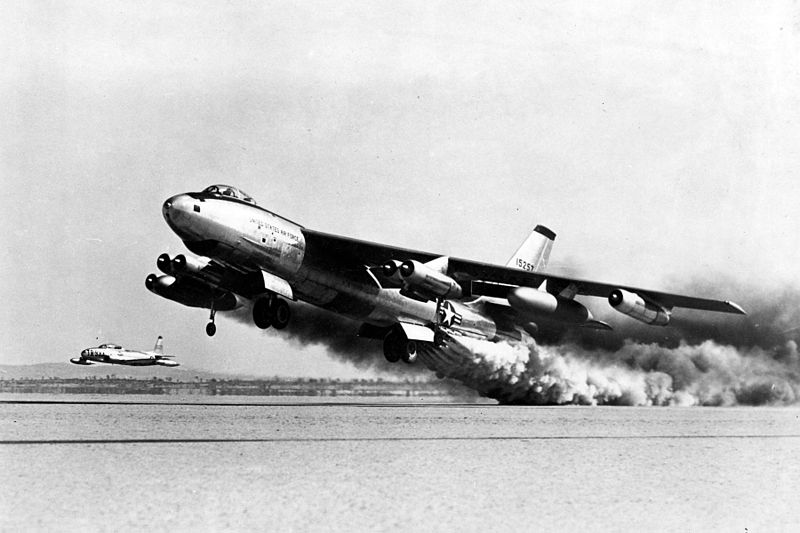Rabat – In 1958, an accidental fire nearly detonated a hydrogen bomb at the USSidi Slimane military base between Rabat and Fez. The culprit was one of the rear wheels of a B-47 bomber carrying a nuclear bomb, which caught on fire.
Many Moroccans could have lost their lives in a nuclear disaster. However, no one in Morocco knew of the incident at that time except Morocco’s King Mohammed V. The US Department of Defense preferred to keep it secret, according to an account from the book “Command and Control” by Eric Schlosser.
After World War II, the US wanted to install its military bases with nuclear weapons as close as possible to the (now former) Soviet Union, its enemy at that time. In 1951, France granted the US territory in Morocco to build a military airbase capable of deploying the B-36 and B-47 bombers. By 1954, the US had secretly stockpiled nuclear weapons at the base, unbeknownst to France.
Two years later, when Morocco gained independence, national pressure mounted within the country to expel the US from their air bases. Under pressure, the US closed its bases in the fall of 1963. But before the US left the North African country, a catastrophic incident that could have killed many in Sidi Slimane was narrowly averted.

B-47s strategic bombers parked at Sidi Slimane in August 1954, four years before the 1958 incident – Unredacted
On January 31, 1958, one of the rear wheels of a B-47 bomber caught on fire on the runway at the US air base at Sidi Slimane during a simulated maneuver. The plane was carrying a Mark 36 bomb, a second-generation hydrogen bomb. The Mark 36 is an armed 4-ton atomic bomb. It was a transitional weapon, combining the old technologies of the atomic bombs dropped on Japan with new technologies.
The fire spread to the bomber’s fuel tank and destroyed it. Fortunately, the crewmen escaped without injury. But there was still danger that the bomb would detonate. Firefighters sprayed the remaining burning parts of the bomber and then withdrew.
According to Schlosser, “The flames reached the bomb, and the commanding general at Sidi Slimane ordered that the base be evacuated immediately.”
Fortunately, the explosives in the bomb burned out but did not detonate.
According to an accident report cited by Schlosser, the Mark 36 hydrogen bomb and parts of the B-47 melted into “a slab of slag material weighing approximately 8,000 pounds (about 4 ton), approximately 6 to 8 feet wide and 12 to 15 feet in length with a thickness of 10 to 12 inches.”
The State Department preferred not to broadcast the news about the incident since “a public statement might be distorted by Soviet propaganda and create needless anxiety in Europe,” wrote Schlosser.
When an American diplomat in Paris questioned what happened at Sidi Slimane base, the State Department responded that “the base commander had decided to stage a ‘practice evacuation.’”
American witnesses to Sidi Slimane incident
On April 12, 2013, the National Security Archive, a non-governmental research and archival institution in Washington, D.C., published an article on the Sidi Slimane incident.
The history article received many comments by people claiming to be present at the time of the incident. They still remember that day. They were still children at the time and said their fathers worked for the US army.
“I lived at Sidi Slimane when this happened and remember it well. My Dad was Army Corps of Engineers there to build air strip….” wrote Alexis Namasete.
“The day of the evacuation I was in school – 2nd grade. We were let out and told to go straight home. There were vans driving around the base telling everyone we were being evacuated. We were the last to leave as it was Dad’s responsibility to make sure everyone was off before us. Mom kept suitcases packed with clothes and food for these types of situations. We went to Port Lyautey and I don’t think we even spent the night,” he added.
Since the bomb could have leaked radiation after the incident, Namasete recalled, “We had to take our pee to school in a jar to be tested. I don’t remember anyone ever telling us what they were testing for.”
Adrienne Perry, a 5th grader, was also at Sidi Slimane when the incident happened.
“My parents also had positions of responsibility and insisted I evacuate with people that I barely knew because they had to stay behind,” he wrote.
Perry described the situation, saying “It was a truly terrifying experience.”
“What I remember most is the massive cloud of black smoke that followed us all the way to Port Lyautey,” he added.
Port Lyautey, approximately 50 kilometers away from Sidi Slimane air base, is the former name of Kenitra. It was named by France in 1933 after French General Hubert Lyautey. The city was renamed Kenitra in 1956 when Morocco gained independence.
The incident in Morocco is said to be one of the most serious near disasters. Since 1950, the US has had 32 accidents involving nuclear weapons across the world known as “Broken Arrows.”
Taken from moroccoworldnews.com


J’étais militaire sur place à la B.A201 (avec environ 60 camarade) la base a mericaine à été évacuée, sauf, les aviateurs français : nous n’avons jamais reçu d’ordre de notre autorité !! nous avons regardé bruler le B-47 et sa bombe;nucléaire:Mark-36 avec beaucoup d’engoisse…(de 10h le matin à 5..6h le soir environ !) puis les Américains ont eu l’ordre de rentrer tout danger étant écarté : journée de “stress” abandonnés sur la base…ce fait n’a jamais été mentionné! Les contrôles américains nous ont déclaré une forte radio-activité à proximité.!..et nous? dites que c’est seulement un exercice cela doit rester secret ! Je ne peut oublier ce 31 janvier 1958.